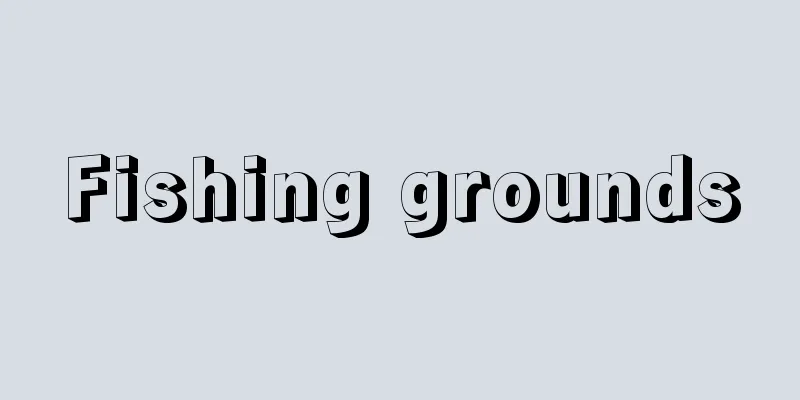Fishing grounds

|
Aquaculture refers to an area where aquatic plants and animals that are the subject of fishery production are concentrated and where they are caught or harvested. Areas in coastal waters where facilities are used to manage the reproduction and growth of plants and animals such as oysters, nori, and wakame are called aquaculture areas. [Ryuzo Takayama] Natural conditions of the fishing groundsThe objective condition for the formation of fishing grounds is a natural environment suitable for the reproduction and growth of aquatic plants and animals. In general, it is a water area where the water temperature is suitable for the life of fish and other organisms, where there is an abundance of nutrients and food, and where the topography and water quality are suitable for growth and spawning. Water areas rich in food essential for the growth of fish and other organisms are water areas where phytoplankton reproduces in large quantities. In addition to carbonate compounds and light, phytoplankton require nutrients such as nitrogen, phosphorus, and silicon to reproduce. In the aquatic world, these nutrients are produced by the decomposition of the dead bodies of animals and plants, but most of them sink to the bottom of the water, and if they are deep enough that sunlight does not reach them, phytoplankton cannot use the nutrients. Therefore, water areas where phytoplankton reproduces in large quantities are, firstly, coastal shallows where sunlight penetrates to the bottom, and continental shelves up to a depth of 200 meters. Secondly, water areas where nutrients from the bottom of the water are carried to the surface of the aquatic world by convection. This convection occurs on a large scale in polar and subpolar waters. In these waters, the temperature drops significantly in winter, so the water surface cools and the density of the surface water increases, causing it to sink. This results in convection. Thirdly, there are waters with protruding seabeds, such as reefs and shallows. There, upwelling currents occur, which cause seawater with a high nutrient content in the bottom layer to bubble up to the surface. Fourthly, there are tidal boundaries, which are formed when seawater with different temperatures and salinities, such as warm and cold currents, come into contact. In these tidal boundaries, convection also occurs due to differences in flow speed, making the waters rich in nutrients. In these waters, large amounts of phytoplankton, as well as zooplankton and small fish that feed on them, proliferate, attracting fish and other creatures that seek food. The fishing grounds formed in this way are feeding fishing grounds. After the feeding period, fish enter the spawning season. For example, chum salmon spend 3 to 4 years in the food-rich North Ocean, and as the spawning season approaches, they gather along the shores of their natal river in search of a mate, and eventually swim upstream to the same river where they spent their juvenile period. During this time, chum salmon stop feeding and simply search for a suitable spawning bed. Spawning fishing grounds are formed when fish gather in waters suitable for spawning in this way while searching for a mate to reproduce. [Ryuzo Takayama] Development of fishing groundsFishing grounds are established by the production activities of catching and harvesting the natural conditions mentioned above. Fishing grounds are classified into sardine fishing grounds, pacific saury fishing grounds, etc. according to the species of fish caught, bottom trawl fishing grounds, angling fishing grounds, gillnet fishing grounds, etc. according to fishing gear and fishing method, and coastal, offshore, and deep sea fishing grounds according to the water area. Furthermore, by combining the fish species and fishing method, they are classified into sardine purse seine fishing grounds, yellowtail fixed net fishing grounds, salmon and trout drift net fishing grounds, and by combining the sea area, North Pacific salmon and trout fishing grounds, North Pacific trawl fishing grounds, etc. In this way, fishing grounds are classified according to the type of fishing production activity and the fish species because they have been formed historically according to the development of fishing technology and productivity. The development of fishing productivity has made it possible to catch marine resources in previously unexplored waters, which has brought large profits to fishing management. Moreover, the vast marine resources of the high seas are not owned by anyone and can be freely harvested. In order to discover and harvest good fishing grounds before anyone else, fishermen have made efforts to make fishing boats larger, more powerful, and improve their nets. As a result, most of the major fishing grounds in the world's waters have been developed to date. However, if a method for utilizing unused marine resources is developed, new fishing grounds will continue to be formed in the future. It was in the 1960s that the technology to process pollock, which was abundant in the northern Pacific Ocean, into surimi on board was developed. Since then, this area has become a good fishing ground for trawl fishing. Historically, fishing grounds have been developed by developed countries, so fishing grounds in the Northern Hemisphere have been developed, and the world's three largest fishing grounds, the Northeast Atlantic, the Northwest Atlantic, and the Northwest Pacific, are all located in the Northern Hemisphere. In the Southern Hemisphere, the history of development is short, except for the sardine fishing grounds off the coast of Peru and the whaling grounds in the Southern Ocean. [Ryuzo Takayama] Today's Fishing IssuesIn the past, fishing grounds and schools of fish were discovered based on the presence of flocks of birds or changes in the color of the seawater, but in modern times, highly accurate fish finders have been developed, and the amount of information on the nature of the ocean, the topography of the seabed, and the ecology of fish has increased, reducing the uncertainty of fishing ground development. In Japan, a fishing ground information system has also been developed that uses satellites to observe seawater temperature and currents and transmits that information to fishing boats. In the historical process of development of fishing grounds and fishing techniques, conflicts arose both domestically and internationally over the occupation and use of good fishing grounds, leading to the enactment of laws such as the Fisheries Law that regulate the use of fishing grounds, and the conclusion of fisheries treaties and agreements internationally. In the late 1970s, countries established 200-nautical-mile economic zones, which placed good fishing grounds under the jurisdiction of each country, and the order of their use changed dramatically. On the other hand, in Japan's coastal waters, especially with the economic development after World War II, good fishing grounds have been reclaimed, and water quality has been polluted by industrial and domestic wastewater. Combined with overfishing caused by the increase in fishing productivity, coastal fishing grounds have been devastated. National and local fisheries administration officials, local fishing cooperatives, and fishers are working to conserve and restore fishing grounds and to create new fishing grounds using artificial reefs and other methods. [Ryuzo Takayama] "New Edition of General Theory of Fisheries Science" by Eiichi Tanigawa, Tadashi Tamura, et al. (1977, Koseisha Koseisha) " "Fish and the Environment" by Ken Kawasaki (1977, Kaiyo Shuppan) Source: Shogakukan Encyclopedia Nipponica About Encyclopedia Nipponica Information | Legend |
|
漁業生産の対象となる水界の動植物が密集している水域で、その捕獲・採取活動が行われる場をいう。また沿岸水域で施設を用いてカキ、ノリ、ワカメなどの動植物の繁殖・生育を管理する区域を養殖漁場という。 [高山隆三] 漁場の自然条件漁場形成の客観的条件は、水界の動植物の繁殖・生育に適した自然環境である。一般的には、魚類その他の生物の生活にとって水温が適温で、栄養分や餌(えさ)に富み、地形や水質などが生育や産卵に適した性質を備えた水域である。魚類等の生育に不可欠な餌が豊富な水域とは、植物プランクトンが多量に繁殖する水域である。植物プランクトンの繁殖には、炭酸化合物と光のほかに、窒素、リン、ケイ素という栄養塩類を必要とする。水界では、この栄養塩類は動植物の死体が分解してできるのであるが、それはほとんどが水底に沈んでおり、太陽光線が届かない深い水底にある場合には、植物プランクトンはその栄養分を利用しえない。したがって植物プランクトンが多量に繁殖する水域というのは、第一に水底まで陽光が透過する沿岸の浅瀬や、水深200メートルまでの大陸棚である。第二に水底の栄養塩類が対流によって水界の表層に運ばれる水域である。この対流は寒帯・亜寒帯水域で大規模におこる。この水域では冬季に気温が大きく低下するので、水面が冷やされ、表面の水の密度が大きくなってそれが沈降する。その結果、対流がおこるのである。第三に暗礁や浅瀬など海底が突起している水域。そこでは底層の栄養塩類に富む海水を表層に湧(わ)き出させる湧昇流(ゆうしょうりゅう)が生ずるのである。第四に暖流と寒流というように、水温や塩分濃度の異なる海水が接してつくる潮境(しおざかい)である。この潮境の水域も、流速の相違なども作用して対流がおこり、栄養分が豊富となるのである。以上あげたような水域には、大量の植物プランクトンとそれを餌とする動物プランクトンや小魚が繁殖し、餌を求める魚類等が集まってくる。こうして形成される漁場が索餌(さくじ)漁場である。 魚類等は摂餌期を経て、産卵期を迎える。たとえばシロザケは餌の豊富な北洋で3~4年を過ごし、産卵期が近づくと生殖の相手を求めて母川(ぼせん)沿岸に集まってきて、やがて、稚魚の時期を過ごした母川を遡上(そじょう)する。この時期にはシロザケは餌をとらなくなり、ただ、適した産卵床を探し求めるのである。このように生殖の相手を求めながら産卵に適した水域に魚類が密集して形成するのが産卵漁場である。 [高山隆三] 漁場の開発漁場は、以上のような自然的条件を基礎として、それを捕獲・採取する生産活動によって成立する。漁場は漁獲対象の魚種によって、イワシ漁場、サンマ漁場などに分類され、漁具・漁法によって、底引網漁場、釣り漁場、刺網漁場などに、また水域によって、沿岸、沖合、遠洋漁場に分類される。さらに魚種と漁法とを組み合わせて、イワシ巻網漁場、ブリ定置網漁場、サケ・マス流し網漁場、また海域と組み合わせて、北洋サケ・マス漁場、北洋トロール漁場などに分類される。このように、漁場が漁業生産活動の形態と魚種によって分類されるのも、漁場が漁業の技術的、生産力的発展にしたがって歴史的に形成されてきたからである。漁業生産力の発展が、それまで未開拓であった水域の水産資源の漁獲を可能とし、それが漁業経営に大きな収益をもたらしてきた。しかも広大な公海の水産資源はだれの所有にも属さない、自由に漁獲しうる資源であったから、優良な漁場をだれよりも早く発見し漁獲するために、漁業者は漁船の大型化、動力化、網の改良に努め、その結果、今日までに、世界中の水域の主要な漁場のほとんどを開発してきた。しかし、未利用の水産資源の利用方法が開発されれば、今後も新たな漁場が形成されるのである。北部太平洋海域に豊富に生息していたスケトウダラを、船上ですり身に加工する技術が開発されたのは1960年代のことであった。そのとき以降この海域はトロール漁業の優良漁場となったのである。歴史的には、漁場は先進諸国によって開発されてきたから、北半球の漁場開発が進んでおり、世界の三大漁場といわれる北東大西洋漁場、北西大西洋漁場、北西太平洋漁場はいずれも北半球にある。南半球は、ペルー沖合いのイワシ漁場と、南氷洋の鯨漁場以外は、開発の歴史が浅い。 [高山隆三] 今日における漁場問題漁場、魚群の発見には、かつては鳥の群がる状況や海水の色の変化などを手掛りとしていたが、現代では精度の高い魚群探知機が開発され、海洋の性質や海底の地形、魚類等の生態に関する情報量が増し、漁場開発の不確実さが小さくなってきた。わが国では、人工衛星によって海水温・海流などを観測して、その情報を漁船に送信する漁場情報システムも開発されてきている。 漁場開発と漁獲技術の歴史的発展過程で、国内的にも国際的にも優良漁場の占有・利用をめぐって紛争が生じ、漁場の利用方法を規制する漁業法などの法律が施行され、国際的には漁業条約・漁業協定が結ばれてきた。国際的な優良漁場は、1970年代後半に各国が200海里経済水域を設定したことによって、各国の管轄下に置かれることになり、その利用秩序は大きく変化したのである。他方、わが国の沿岸水域では、とくに第二次世界大戦後の経済発展に伴い、優良漁場の埋立てが進行し、また工場・生活排水によって水質が汚染され、漁業生産力の上昇によって引き起こされてきた乱獲と相まって、沿岸漁場が荒廃してきており、政府・地方自治体の水産行政当局者、地域の漁業協同組合と漁業者は、漁場の保全・回復と人工魚礁などによる漁場の造成に努めている。 [高山隆三] 『谷川英一・田村正他著『新編水産学通論』(1977・恒星社厚生閣)』▽『川崎健著『魚と環境』(1977・海洋出版)』 出典 小学館 日本大百科全書(ニッポニカ)日本大百科全書(ニッポニカ)について 情報 | 凡例 |
<<: Fisheries system - Gyojouseido
Recommend
Geg
...In addition to Albania itself, there are a few...
Amnemachine [Mountain] - Amnemachine
It is the main peak of the mountain range that is ...
Daphnis and Chloe - Daphnis and Chloe (English)
An ancient Greek love story. It is said to have b...
Eyadéma, G. (English spelling) EyademaG
...The Kabre people, a representative example of ...
Kisarazu ship
[Noun] A small cargo ship that traveled between Ki...
Reticulated King Crab - Reticulated King Crab
…It is found widely from Tokyo Bay to the South P...
soilless culture
...A method of cultivating plants without using s...
F Number - F Number
…Also called F-number. A numerical value that ind...
Anthropology
…Based on these achievements, the foundations of ...
Utsushie - Utsushie
A child's toy with colored prints of people, f...
Chinese science (English)
Just before the end of the 15th century, a fleet l...
Baibunsha - Baibunsha
A kind of ghostwriting business that brought toge...
Keigo Kiyoura
A bureaucrat and politician from the Meiji to Tai...
Aburake - Aburake
...The name probably comes from the fact that the...
Overhead transmission - Overhead transmission
…When increasing the voltage from 500kV to 1000kV...









